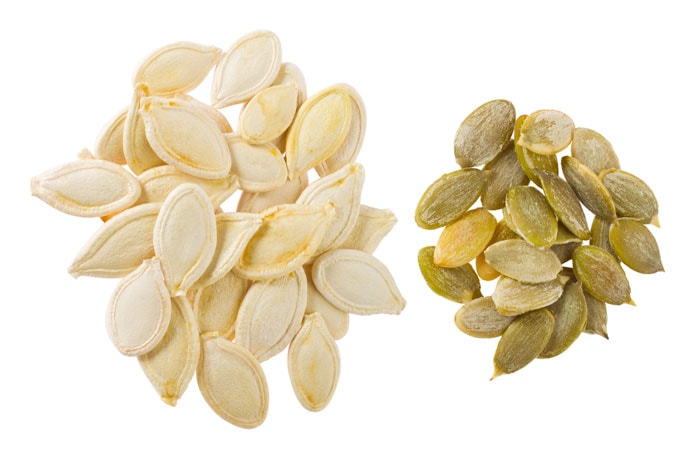
Written By: Sofia Layarda, MPH
Title: Master of Public Health
Alumni: University of California, Berkeley
Last Updated on:

Perhaps it’s time to take a closer look at something inside the pumpkin that often ends up in the compost bin – the seeds. Also known as pepitas, toasted pumpkin seeds are a popular snack in Mexico. While they are freshest during fall and winter, when pumpkins are in season, they can be found year-round in the nuts & snack section, or the bulk section of most grocery stores.
Pepitas are flat and typically dark green in color. When raw, they have a somewhat chewy texture and a subtly sweet flavor.
Table of Contents
1 oz of dried pumpkin seeds1 contains:

Approximately 75% of the fats in a serving of pumpkin seeds are heart-friendly mono- and polyunsaturated fats. They are also a rich source of phytosterols2, which have powerful cholesterol-lowering properties. Why bother with fancy butter-like imitation spreads with added sterols when phytosterols already exist in these tasty little seeds?
Pumpkin seeds are also rich in the minerals manganese and magnesium. Manganese is a nutrient involved in numerous metabolic processes and protection against oxidative damage, while magnesium plays an important role in bone health and cardiovascular health. In addition, pumpkin seeds are good sources of phosphorus, iron, copper, Vitamin K, and zinc. That’s a whole lot of nutrients packed into a tiny package!
Because of their nut-like flavor and fat content, pepitas make a beautiful substitute for nuts in recipes such as pesto when you are cooking for someone with a nut allergy. Although you can buy them at the store, it is fairly easy to save and roast your own seeds from your Halloween pumpkin so you can store them for future use. Once you get the seeds out of the pumpkin, give them a quick rinse and wipe to remove any pulp that stuck, then spread them out evenly on a paper bag and let dry overnight. The next day, lightly roast them in a single layer on a cookie sheet (170F for 15 to 20 minutes). Let cool, then store them in an airtight container in the fridge. Ideally, you should use them up within a couple of months.
HealthCastle has strict sourcing guidelines. We reference peer-reviewed studies, scientific journals and associations. We only use quality, credible sources to ensure content accuracy and integrity.
Alumni: University of California, Berkeley – Sofia believes in bringing back fun and pleasure into everyday eating. She loves cooking, and is constantly experimenting with ingredients, creating recipes and trying them out on family and friends. Her latest interest lies in finding realistic and practical ways of environmentally-friendly food/eating habits.
grocery aisle, healthy every month, pumpkin seeds
thank you but it also used to remove tapeworms from human intestine